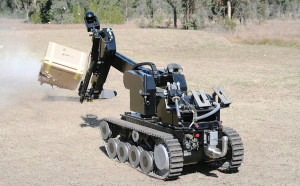How Does A Bomb Disposal Robot Work
Bomb-disposal, or explosive ordnance disposal (EOD), robots are one of the many tools a technician might use to disarm dangerous weapons.
Besides the human cost of losing a bomb technician in the field, training a bomb-disposal officer is significantly more expensive than buying an EOD robot.
As a result, maintaining a safe distance from a potential bomb is of paramount importance and only in extreme situations will the technician enter the blast range and put their hands on the device themselves.
One of the most widely used bomb-disposal robots today is the Cobham tEODor (pictured). The base robot is a twin-track vehicle with a host of military applications, but the standard tEODor is the bomb-disposal specialist. It’s equipped with an arm-like manipulator, sensors and a camera on a boom for enabling the operator to remotely disarm ordnance and improvised explosive devices (IEDs).
In most cases, the technician working with the robot will sit at a safe distance with the control station. This is a laptop-like device which consists of a monitor showing the robot’s point of view as well as its surroundings, plus a joystick and control panel to manipulate the arm and manoeuvre the tracks.
![Cobham tEODor]() tEODor parts
tEODor parts
Communications – A two-way radio and digital video transmitter provides a link between the bot and its operator.
Gripper – Different grippers are used for precision and/or power. There’s even a specific one for towing vehicles.
Arm – The arm can be equipped with an X-ray and image plate in order to see inside suspicious packages.
Tracks – Steel tracks with sprung rollers enable the tEODor to climb steep inclines of up to 45 degrees at a max speed of 3km/h (1.9mph).

